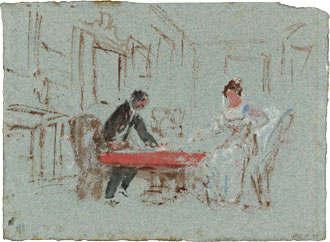|
| Magriel's NYT Columns |
 The fourth Big Apple Backgammon Championship, sponsored by the Metropolitan Backgammon Association, was held in New York last week. Dr. Robert Hill defeated Lou Tyrell to take first place in the championship division; Mike Valentine and Julian Zissman were semifinalists. Alphonse Mekalainas won the consolation; Ray Sawchak beat Andy Traskin for the intermediate.
The fourth Big Apple Backgammon Championship, sponsored by the Metropolitan Backgammon Association, was held in New York last week. Dr. Robert Hill defeated Lou Tyrell to take first place in the championship division; Mike Valentine and Julian Zissman were semifinalists. Alphonse Mekalainas won the consolation; Ray Sawchak beat Andy Traskin for the intermediate.
One intermediate player (Black) made a costly mistake in the diagrammed position. White has already doubled and has reached a winning position, having borne 12 men off. Although Black has no chance to win, the game continues to see whenter Black will lose a double game (or gammon).
|
| Black to play 6-1. |
A careful evaluation shows that Black will have a difficult time averting the gammon. White is a strong favorite (better than 90 percent) to bear off his remaining three men with two more rolls. Black will then have only one remaining roll (after he completes this play) in which to get a man off. Unfortunately, Black must rely on certain specific doubles this next roll. Precise calculation is needed to determine exactly which doubles will suffice.
In the game, Black carelessly played 12/6, 15/14, bringing one man into his home board, and moving his other outfield man closer to home. Black next rolled 5-5’s and was surprised to discover that he was unable to bear a man off, even though his first two 5’s got him home. (Note that the rules equire at least one man off to save the gammon; merely having all men in the home board is not sufficient.)
Afterwards, one of the spectators, who had himself been eliminated in an earlier round, was eager to point out Black’s mistake. “If you had played 12/5 instead, then double 5-5’s as well as 3-3’s and 6-6’s would have taken a man off.“
The spectator’s recommendation was indeed an improvement — but still the wrong play. The correct play is 15/9, 6/5. This move gives Black the best chance to come off next roll. The reader may verify that now, in addition to 3-3’s 5-5’s, and 6-6’s, 4-4’s will also enable Black to avoid the gammon.
The general rule for saving the gammon is to bring all your men into your home board as quickly as possible. In so doing, it is critical not to “waste” any pips inside your home board. However, exceptions to this principle do occur, particularly when there is only one roll left to play, as in this position. In these one-roll positions, there are not rigid guidlines to determine the best play. All the alternatives must be examined on a roll-by-roll basis and the resulting chances compared.
Rollout
 Tom Keith 2013 |
|
Money play Black owns 2-cube Black rolls 6-1 1296 games with VR Checker play: 2-ply Cube play: 3-ply Red |
| 6-1: | Game | G | BG | Equity | ||||
| 1 | 15/9, 6/5 |
W L |
.0000 1.000 |
.0000 .8326 |
.0000 .0000 | −1.8326 |

| (b) |
| 9 | 15/14, 12/6 |
W L |
.0000 1.000 |
.0000 .8727 |
.0000 .0000 | −1.8727 | (0.0401) | (a) |

|
|

